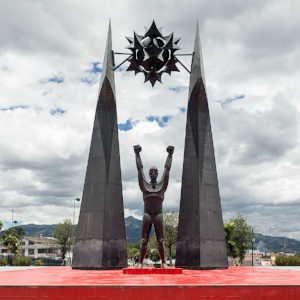Having lived in Sangolquí for a year, I thought there were many things which were simply unknown. For example, I always wondered why this valley was called the Los Chillos Valley. I asked and no one seemed to know the answer. While I know a great deal about our community currently, I never fully understood the history behind the area where we work. I finally got the answers I was looking for when community members (once known as my host parents) Christian and Laura came to the Library to give a short talk about the history and culture in Rumiloma, the community where our Library is located. All 10 of us crowded into the darkest room in the Library at 11:00 am, to watch a presentation from Christian. Not only was this talk informative and interesting, but it also helped Program Directors gain perspective on how important our work is here in the Los Chillos Valley. In order to make this post as interesting as the talk actually was, I wanted to provide key takeaways from the story of Rumiloma:
The larger valley where we live and work is called the Los Chillos Valley, named by the indigenous Mitmakunas who settled in this area in the early 1400’s. The Valley is located in a county known as Rumiñhaui, and Sangolquí is the largest city in this county. Within Sangolquí, there are many neighborhoods. One of these is Rumiloma, where we work on a daily basis!
The County of Rumiñahui is one of the Smallest in Ecuador! It gained its independence in the month of May and has a large celebration each year. It is also surrounded on all sides by the county of Quito!
Rumiloma used to be made up of only 6 families! An area which is now known as being semi-urban with houses occupying almost every block was once all farmland. This farmland was filled with large Haciendas. After wealthy families owned Haciendas, many were ousted from their land for not paying taxes, and the land was then parceled out to community members at a cheap price. The area has grown significantly since this time and now boasts over 100 families.
Rumiloma is known as “a town where people come to sleep” because it is so close to the capital city of Quito. Most individuals work in Quito and Rumiloma is a commuter town. Therefore, during the day the town is filled with kids and mothers, while fathers and women of working age are in Quito working. This is a major reason why so many of our programs at Manna over time have been geared towards Women and Children!
Oswaldo Guayasamin, the famous painter was born in Sangolqui! Although he did not technically live in the Rumiloma area, he was born in the same valley and town where we work. He even created a famous statue to honor his hometown.
The Rumiñahui statue designed and constructed by Oswaldo Guayasamin located in downtown Sangolquí.
After the presentation, we had a question and answer session with Christian and Laura, who have spent a great deal of time living in and researching about this community. Program Directors asked why community members had such an interest in English and what were other community needs here, and received answers that will help shape our programs for the future. This talk not only taught Program Directors about the community where they are working but also explained more about Ecuadorian culture at an early stage in their time here in Ecuador.
To learn more about a new culture and be able to have in-depth discussions with community members about their lives and experiences, apply to be a Program Director today!




















